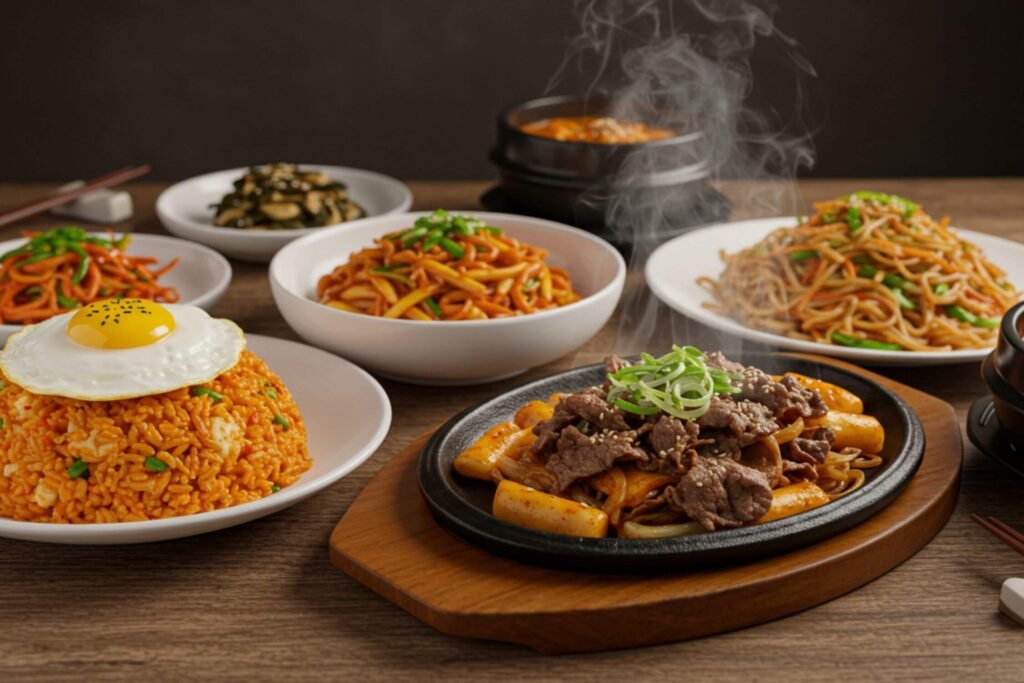Korean cuisine has taken the world by storm. From K-dramas to K-pop, the global interest in South Korean culture has never been higher, and food is a huge part of that wave. But you don’t need a plane ticket to Seoul or a reservation at a Korean restaurant to enjoy delicious Korean meals. With the right ingredients and a bit of curiosity, you can bring the vibrant flavors of Korea into your own kitchen.
Whether you’re new to Korean cooking or a seasoned home chef, these 10 popular Korean dishes are easy to make at home and guaranteed to impress your family or friends. Let’s dive into the best Korean dishes you can whip up without needing professional skills or hard-to-find ingredients.
1. Kimchi fried rice
Kimchi fried rice is a perfect way to use up leftover rice and slightly aged kimchi. It’s spicy, tangy, and packed with umami. All you need is some chopped kimchi, cooked rice, a bit of sesame oil, and soy sauce. You can throw in extra veggies, a bit of spam, or even bacon to enhance the flavor. Top it all off with a fried egg and you’ve got a satisfying Korean comfort dish ready in under 15 minutes.
The best part? It’s very forgiving. Even if you’re not precise with your measurements, it almost always turns out delicious. If you’re looking for a quick weekday dinner or a late-night snack, kimchi fried rice is your go-to.
2. Korean beef bulgogi
Bulgogi, which means “fire meat,” is one of Korea’s most famous barbecue dishes. Thin slices of beef (usually ribeye or sirloin) are marinated in a sweet and savory mix of soy sauce, sugar, garlic, sesame oil, and grated pear for tenderness. After just 30 minutes of marinating, you can cook the beef in a pan or grill until it’s caramelized and juicy.
Served with rice, lettuce leaves, and perhaps a dab of ssamjang (a Korean dipping sauce), bulgogi is an easy yet flavorful meal. The ingredients are commonly found at most grocery stores, and you don’t need a fancy grill—just a good pan will do the trick.
3. Japchae (stir-fried glass noodles)
Japchae is a Korean party favorite, but it’s also easy enough to make on any given day. It features chewy glass noodles made from sweet potato starch, stir-fried with colorful vegetables like spinach, carrots, mushrooms, and onions. Often, thin slices of beef are added, but it’s just as tasty when made vegetarian.
The key to great japchae lies in cooking each ingredient separately to maintain its texture, then tossing everything in a slightly sweet soy-based sauce. It’s light, healthy, and absolutely bursting with flavor. Plus, it tastes great both warm and cold, making it ideal for meal prep.
4. Kimchi jjigae (kimchi stew)
If you love soups and stews, then kimchi jjigae will hit the spot. It’s a hearty, spicy stew made with kimchi, tofu, pork belly (or canned tuna), and onions. Simmered until the flavors meld, it delivers that signature Korean depth of flavor—spicy, sour, and savory.
This dish works especially well with over-fermented kimchi, so don’t toss that sour batch in the back of your fridge. You’ll need gochugaru (Korean red pepper flakes) and a dash of fish sauce to create the authentic taste. Pair it with a bowl of white rice and you’ll understand why this dish is a staple in Korean households.
5. Tteokbokki (spicy rice cakes)
Tteokbokki is a street food classic that’s spicy, chewy, and addictive. It’s made with cylindrical rice cakes simmered in a thick sauce of gochujang (Korean red chili paste), sugar, and soy sauce. Fish cakes and boiled eggs are often added for extra protein and texture.
Despite its bold flavors, tteokbokki is surprisingly easy to make at home. Most Asian grocery stores carry the rice cakes and gochujang needed for the dish. Once you try homemade tteokbokki, you may never go back to instant versions again.
6. Samgyeopsal (grilled pork belly)
Samgyeopsal is Korea’s beloved grilled pork belly dish, often enjoyed with friends and family. While it’s usually cooked on a table-top grill at Korean BBQ restaurants, you can easily recreate the experience at home using a skillet or a portable grill.
Thick slices of pork belly are grilled until golden and crispy. They’re then wrapped in lettuce with garlic, sliced chilies, and ssamjang. Serve it with side dishes like kimchi, pickled radish, and steamed rice for the full experience. It’s interactive, fun, and incredibly satisfying.
7. Doenjang jjigae (soybean paste stew)
Another comforting stew in Korean cuisine is doenjang jjigae, made with fermented soybean paste (doenjang), tofu, zucchini, mushrooms, and sometimes seafood or beef. It’s similar to miso soup but with a much deeper, richer flavor thanks to the fermented paste.
It’s one of the simplest Korean dishes to make. Boil some water with anchovy stock, add a spoonful of doenjang, toss in your vegetables, and let it simmer. It’s hearty, healthy, and perfect for cold evenings. Pair it with a bowl of rice for a complete meal.
8. Pajeon (Korean scallion pancakes)
Crispy, savory, and perfect as a snack or side dish, pajeon is a crowd-pleaser that’s quick to make. The basic version includes a batter made from flour, water, and egg, filled with scallions. For seafood lovers, haemul pajeon includes additions like shrimp, squid, or clams.
Once you pour the batter onto a hot pan, let it cook until the edges are golden and crisp. It’s typically served with a dipping sauce made from soy sauce, vinegar, and a touch of sesame oil. If you’re hosting guests, this is a great starter that looks and tastes impressive but requires minimal effort.
9. Bibimbap (mixed rice bowl)
Bibimbap is arguably one of Korea’s most iconic dishes—and it’s a perfect “clean out the fridge” meal. It starts with a base of warm rice, topped with a colorful array of vegetables like spinach, bean sprouts, mushrooms, carrots, and zucchini. Add a protein like beef or a fried egg, and finish with a generous spoonful of gochujang.
It’s a balanced dish in every sense: visually, nutritionally, and in flavor. The mix of spicy, savory, and earthy components is irresistible. Once everything is mixed together, each bite is slightly different yet equally delicious.
10. Gyeran mari (rolled egg omelet)
Simple but elegant, gyeran mari is a rolled egg omelet often seen in Korean lunchboxes. It’s made by whisking eggs with finely chopped vegetables like carrots, onions, and scallions. The mixture is poured in layers into a nonstick pan, rolled gently as it cooks to form a neat log.
Once it cools slightly, it’s sliced into rounds. Gyeran mari is great as a side dish or even a breakfast option. It’s also kid-friendly and customizable—add cheese, seaweed, or ham for extra flair. Despite its simplicity, it brings a distinct Korean touch to your table.
Bottom line
You don’t have to be a professional chef or have access to specialty equipment to start cooking Korean food. Many of the ingredients, like gochujang, soy sauce, sesame oil, and kimchi, are now widely available at major grocery chains or online. Once you stock up on a few basics, you’ll find that many Korean recipes share common ingredients, making it easier and more economical to cook them regularly.
Korean cooking is all about balance—sweet and salty, spicy and savory, crunchy and soft. It emphasizes fresh ingredients, fermentation, and bold flavors. Even better, many Korean dishes are healthy, colorful, and visually pleasing, perfect for sharing on social media or with family.



